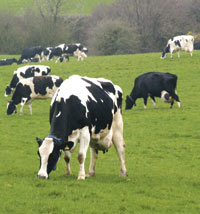Grass bred to reduce greenhouse gases

Breeding grasses to improve nitrogen use efficiency in the rumen could be part of the solution to reducing greenhouse gas emissions, according to Jon Moorby, IBERS.
Speaking at the British Cattle Breeders Conference, he said; “Reducing the excretion of nitrogen and energy-rich substances is a major goal, not only because of the loss of animal productivity, but also because of the release of greenhouse gases.
“And the improvement to grass has a significant role to play in these objectives.”
Although energy is efficiently extracted from forage by the rumen microbes, proteins are typically used inefficiently with a large proportion of N being excreted.
“This can be as much as 70-80% of dietary intakes in dairy cows,” said Dr Moorby.
“In fact, in the EU, land nitrogen surplus from cows and fertiliser is about 68kg N/ha. The question is, how can we reduce nitrogen excretion from the ruminant?
“In forages, nitrogen/protein is usually quickly available after consumption, but energy is less rapidly accessible.”
This difference in time release and balance means the rumen microbes may be energy limited and are, therefore, incapable of converting forage proteins into microbial proteins. Some of this waste protein will then be excreted as waste nitrogen in the urine.
“By increasing the amount of available energy during the early part of fermentation to match quickly available nitrogen sources, it should theoretically improve nitrogen use and reduce its excretion.”
“The rapidly available energy in forages comes mainly from water soluble carbohydrates, WSC.”
In fact, high sugar/WSC ryegrasses bred at Aberystwyth, were found to increase intakes and yields, but more consistently were also found to reduce the proportion of dietary nitrogen excreted in the urine. “This demonstrates a decrease in inefficiency and a significant reduction in greenhouse gas emissions.”
Another way of reducing nitrogen excretion is to alter the rumen degradability of the forage protein to reduce its availability to rumen microbes and match the availability of WSC present.
“A number of forage plants contain Polyphenol oxidase, a common enzyme that causes an apple to turn brown on exposure to oxygen,” he explained. PPO is present in high quantities in red clover and consequently, when the leaf undergoes damage such as at cutting or clamping, PPO forms protein complexes.
“These protein complexes are relatively resistant to degradation, slowing breakdown in the rumen and matching protein and energy release together.”
And the recent discovery of PPO activity in forage grasses, such as cocksfoot could allow the transfer of genetic material from these grasses to provide a protein protection mechanism that can be exploited.
“In the future, it could be possible to incorporated PPO activity into ryegrass breeding,” Dr Moorby said.
